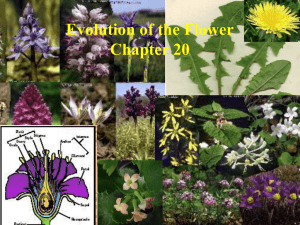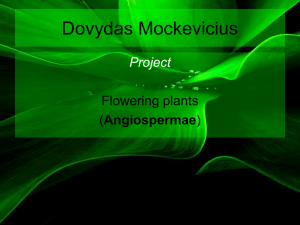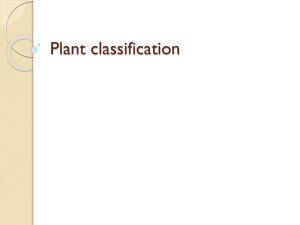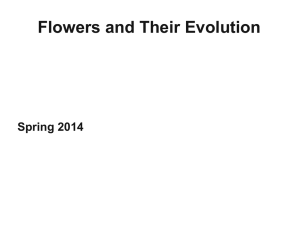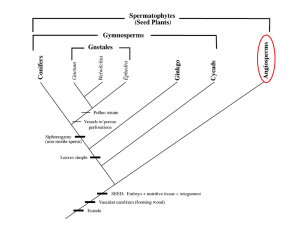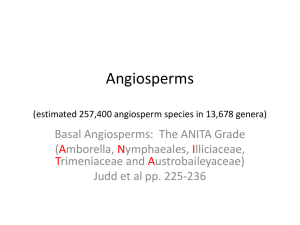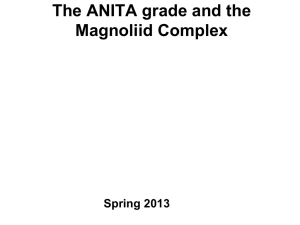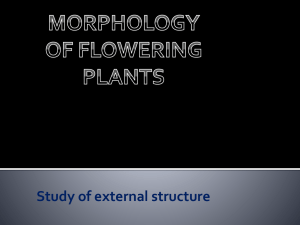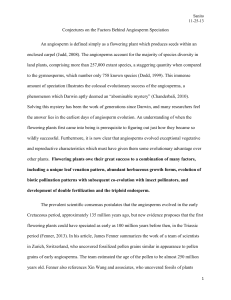Chapter_06_Review_Questions
advertisement
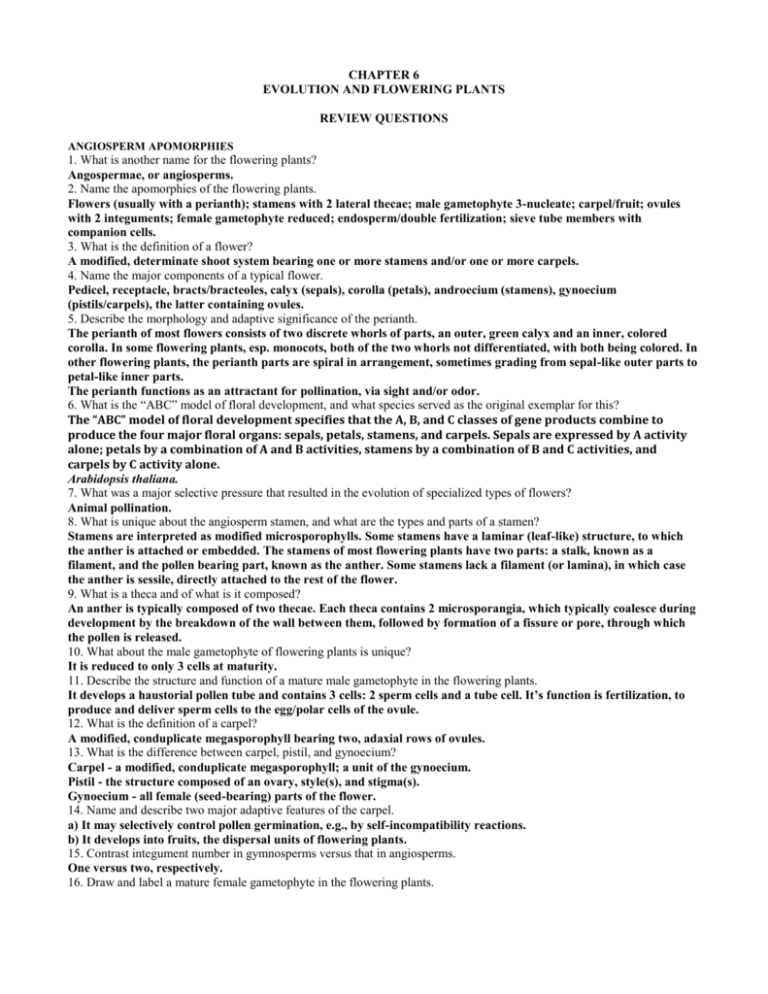
CHAPTER 6 EVOLUTION AND FLOWERING PLANTS REVIEW QUESTIONS ANGIOSPERM APOMORPHIES 1. What is another name for the flowering plants? Angospermae, or angiosperms. 2. Name the apomorphies of the flowering plants. Flowers (usually with a perianth); stamens with 2 lateral thecae; male gametophyte 3-nucleate; carpel/fruit; ovules with 2 integuments; female gametophyte reduced; endosperm/double fertilization; sieve tube members with companion cells. 3. What is the definition of a flower? A modified, determinate shoot system bearing one or more stamens and/or one or more carpels. 4. Name the major components of a typical flower. Pedicel, receptacle, bracts/bracteoles, calyx (sepals), corolla (petals), androecium (stamens), gynoecium (pistils/carpels), the latter containing ovules. 5. Describe the morphology and adaptive significance of the perianth. The perianth of most flowers consists of two discrete whorls of parts, an outer, green calyx and an inner, colored corolla. In some flowering plants, esp. monocots, both of the two whorls not differentiated, with both being colored. In other flowering plants, the perianth parts are spiral in arrangement, sometimes grading from sepal-like outer parts to petal-like inner parts. The perianth functions as an attractant for pollination, via sight and/or odor. 6. What is the “ABC” model of floral development, and what species served as the original exemplar for this? The “ABC” model of floral development specifies that the A, B, and C classes of gene products combine to produce the four major floral organs: sepals, petals, stamens, and carpels. Sepals are expressed by A activity alone; petals by a combination of A and B activities, stamens by a combination of B and C activities, and carpels by C activity alone. Arabidopsis thaliana. 7. What was a major selective pressure that resulted in the evolution of specialized types of flowers? Animal pollination. 8. What is unique about the angiosperm stamen, and what are the types and parts of a stamen? Stamens are interpreted as modified microsporophylls. Some stamens have a laminar (leaf-like) structure, to which the anther is attached or embedded. The stamens of most flowering plants have two parts: a stalk, known as a filament, and the pollen bearing part, known as the anther. Some stamens lack a filament (or lamina), in which case the anther is sessile, directly attached to the rest of the flower. 9. What is a theca and of what is it composed? An anther is typically composed of two thecae. Each theca contains 2 microsporangia, which typically coalesce during development by the breakdown of the wall between them, followed by formation of a fissure or pore, through which the pollen is released. 10. What about the male gametophyte of flowering plants is unique? It is reduced to only 3 cells at maturity. 11. Describe the structure and function of a mature male gametophyte in the flowering plants. It develops a haustorial pollen tube and contains 3 cells: 2 sperm cells and a tube cell. It’s function is fertilization, to produce and deliver sperm cells to the egg/polar cells of the ovule. 12. What is the definition of a carpel? A modified, conduplicate megasporophyll bearing two, adaxial rows of ovules. 13. What is the difference between carpel, pistil, and gynoecium? Carpel - a modified, conduplicate megasporophyll; a unit of the gynoecium. Pistil - the structure composed of an ovary, style(s), and stigma(s). Gynoecium - all female (seed-bearing) parts of the flower. 14. Name and describe two major adaptive features of the carpel. a) It may selectively control pollen germination, e.g., by self-incompatibility reactions. b) It develops into fruits, the dispersal units of flowering plants. 15. Contrast integument number in gymnosperms versus that in angiosperms. One versus two, respectively. 16. Draw and label a mature female gametophyte in the flowering plants. 17. How many cells and nuclei are present in a typical, mature, female gametophyte of the flowering plants? 7 cells, 8 nuclei. 18. How might the reduced angiospermous female gametophyte be adaptive? It is likely correlated with developmental timing. Fertilization in angiosperms occurs very shortly after pollination, unlike that of the gymnosperms, in which a long period of time may ensue between the two events. Thus, angiosperms have the capacity to more quickly generate seeds. This feature may be of tremendous adaptive value, enabling, for example, the evolution of rapidly spreading annual herbs. 19. What is endosperm and what is its function? Endosperm is a mass of triploid tissue that typically envelopes the embryo of angiosperm seeds, functioning in nutrition. It develops from double fertilization. 20. What is the difference between a sieve cell and a sieve tube member? In what groups are each found? Sieve tube members (found only in angiosperms) differ from the ancestral sieve cells (found in all other vascular plants) in that the pores at the end walls are differentiated, being much larger than those on the side walls. These collections of differentiated pores at the end walls are called sieve plates. 21. What type of tracheary element do most angiosperms have, and what is its adaptive significance? Vessels. They may often result in increased efficiency of water/mineral conduction. ANGIOSPERM ORIGINS 22. When are the earliest definitive angiosperm fossils found? The earliest definitive fossils of flowering plants are dispersed pollen grains from the earliest Cretaceous period, approximately 140 million years ago. The earliest definitive flowers occur slightly later in the fossil record, as early as 130 million years ago. 23. Describe the example of Caytonia and glossopterids as putative angiosperm progenitors, citing evidence for or against this idea. Caytonia possessed reproductive structures similar to those of the angiosperms. The male reproductive structures resemble anthers in consisting of a fusion product (synangium) of three or four microsporangia; however, these differ from angiosperm anthers in being radially (not bilaterally) symmetric. The female reproductive structures of Caytonia consist of a spikelike arrangement of units that have been termed cupules. Each cupule enclosed a cluster of unitegmic ovules/seeds, with a small opening in the cupule near the proximal end. The cupule has been hypothesized as being homologous with the angiosperm carpel. However, the cupule of Caytonia is different from what is presumed to be the ancestral carpel morphology, a conduplicate megasporophyll bearing ovules along two margins. In addition, (monosulcate) pollen grains have been discovered at the micropyle of Caytonia ovules, evidence that the pollen grains were transported directly to the ovules (perhaps by means of a pollination droplet, as occurs in extant gymnosperms), rather than to a stigmatic region where pollen tubes formed. Thus, the cupule apparently did not function as a carpel in terms of a site for pollen germination. Another interpretation of the cupule of Caytonia is that it is the homologue of the second integument apomorphic of all angiosperms, evolving by the reduction of the number of ovules within the cupule to one. Glossopterids were trees with simple leaves having a midrib giving rise to an extensive reticulate venation system. Reproductive structures of some glossopterids consist of an appendage adnate to the leaf base. This appendage, termed a “capitulum,” is often interpreted as a megaphyll partially enclosing ovules on the lower surface. The ovules are orthotropous and unitegmic, with a single integument. Thus, the open, leaf-like capitulum may represent a partially closed megasporophyll, transitional to an angiospermous carpel in which the megasporophyll encloses ovules. The bitegmic ovule characteristic of flowering plants must necessarily have evolved independently in glossopterids. 24. Describe the reproductive structure of Archaefructus and indicate two competing hypotheses for its homology. Archaefructus (with two described species) was apparently an aquatic plant, having dissected leaves and elongate reproductive axes, each of the latter with paired stamens below and several-seeded carpels above. Although Archaefructus appears to have bona fide carpels, its relationship to extant angiosperms is debatable. By one hypothesis the reproductive axis is interpreted as an entire, perianth-less flower (with stamens below and carpels above), the axis perhaps homologous to an elongate receptacle reminiscent of some Magnoliaceae. By this interpretation, this reproductive structure might represent an ancestral flower (or flower precursor), and Archaefructus might be sister to the extant angiosperms. An alternative hypothesis views the reproductive axis of Archaefructus not as a single, achetypical flower, but as an inflorescence of individual, reduced male and female flowers, as seen in some aquatic angiosperms today. By this viewpoint, Archaefructus may just as likely represent an extinct off-shoot of an extant lineage within the angiosperms (such as the Nymphaeales).
